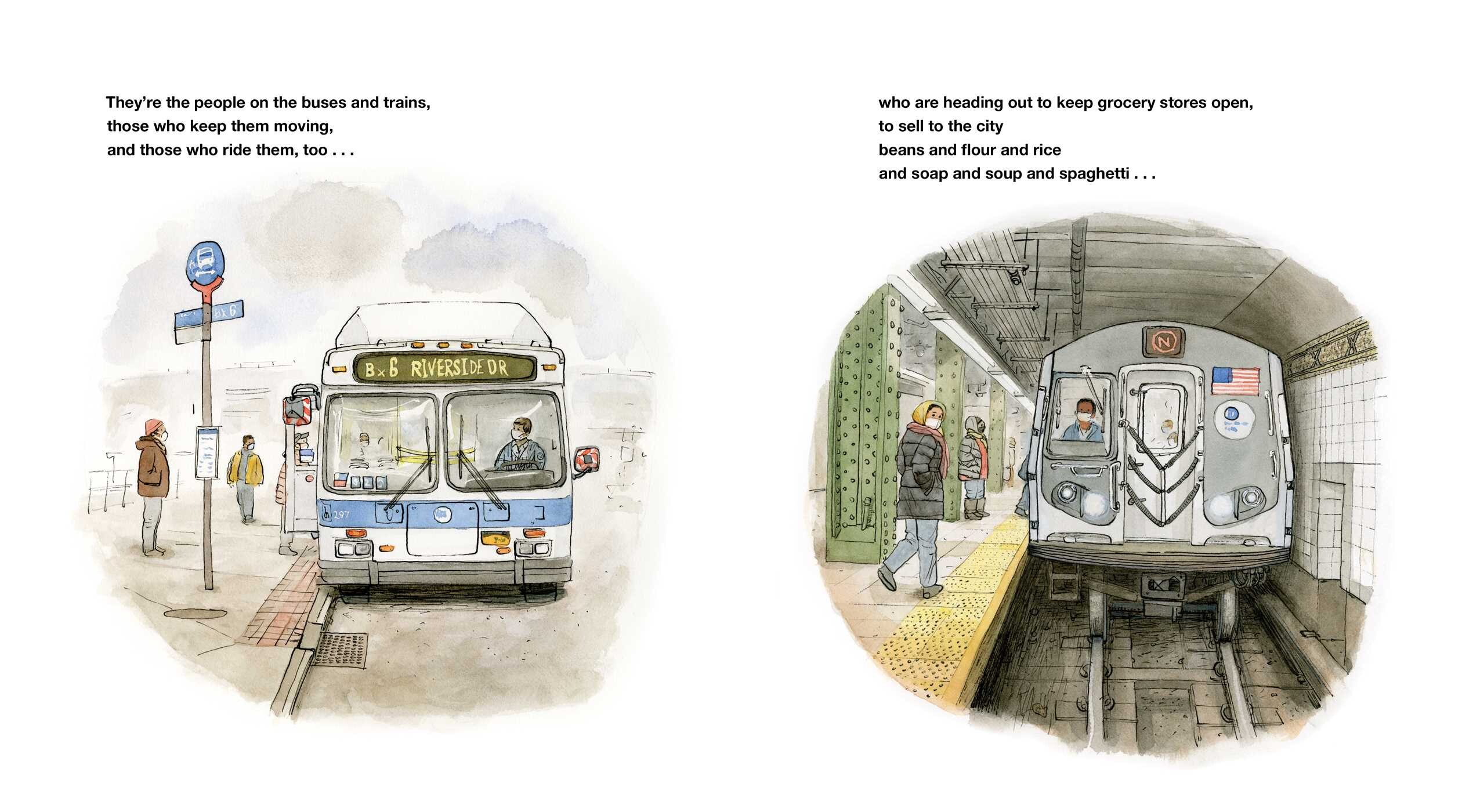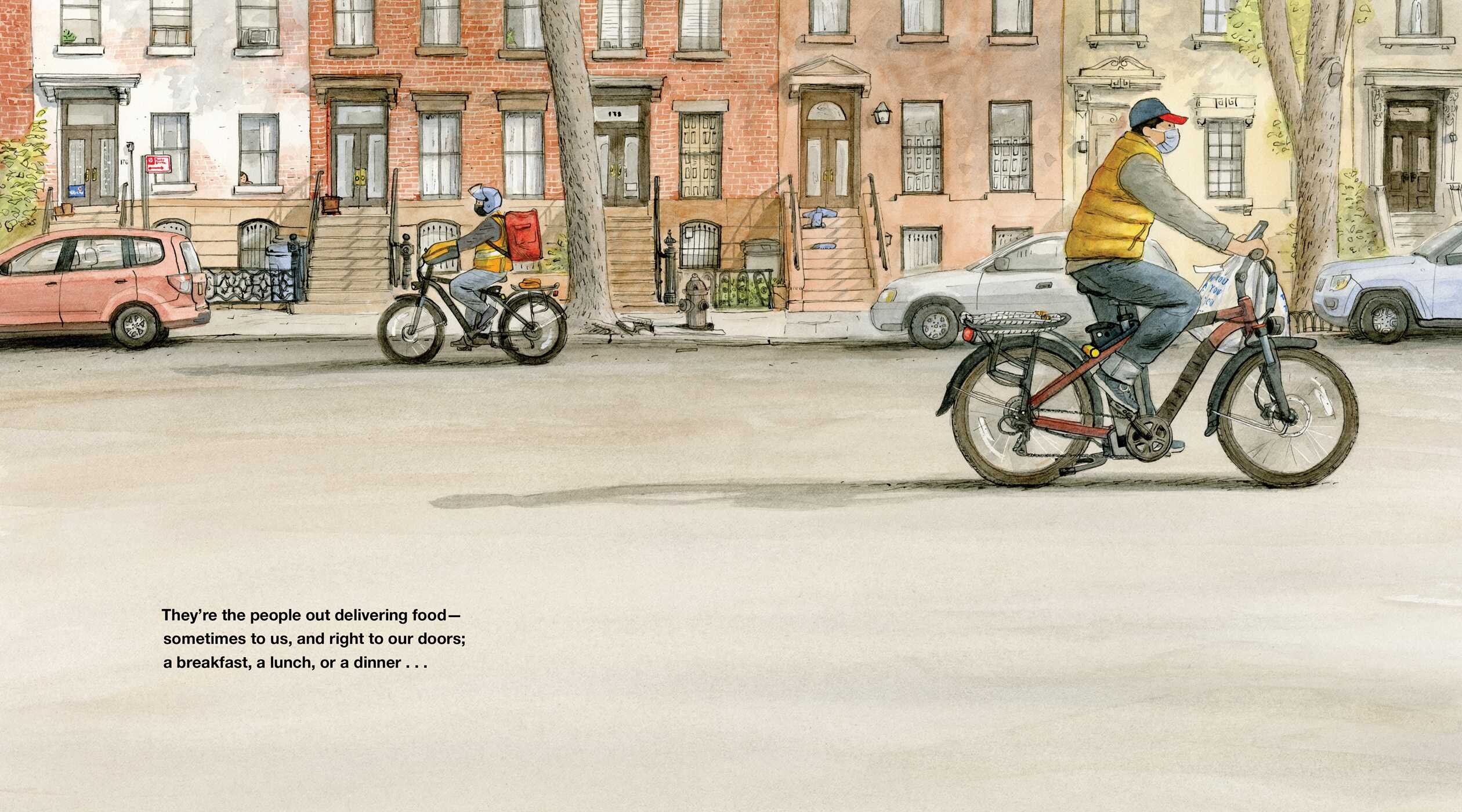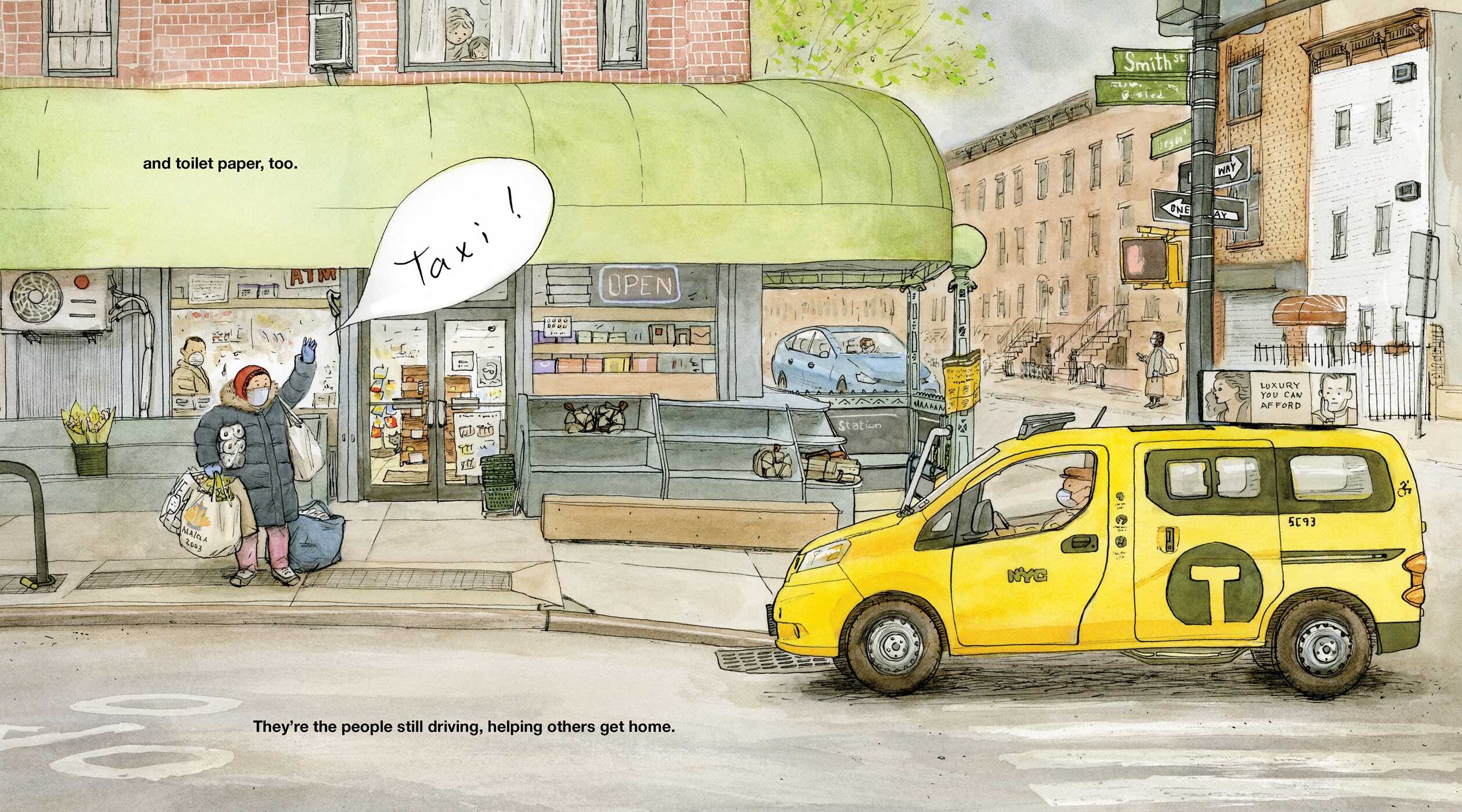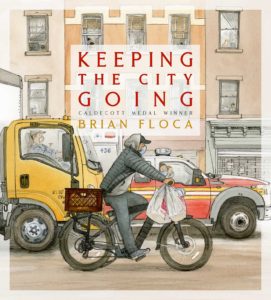40 pages
This month’s PB review is by Ryan G. Van Cleave (#1 city-goer at Only Picture Books) and freelance author/illustrator Kelly Light.
–Ryan’s Review of the Writing–
Brian Floca’s new picture book, Keeping the City Going, tells a familiar story since it’s one we all lived some version of since early 2020. Our narrator is a young child who immediately turns the story’s focus outward into the “almost, but not entirely” empty streets where a few people are “there because we need them.” What Floca is directing our attention to are those who continued to work to keep the city going when COVID-19 threatened to shut everything down.

Bus drivers, train engineers, food delivery people, police officers, taxi drivers, trash collectors, postal carriers, package couriers, construction crews, EMTs, doctors, nurses, aides, and more–they’re all here in these pages, each nobly doing what has to be done so that we can “not feel so alone” and that we can “stay connected.”

While the art is on par with Floca’s award-winning work in his other books–I’ll let Kelly explain why below–his attention to sound is truly interesting. It starts with the awareness that “the voice of the city is low,” but as the story continues and we witness the work of so many brave souls, the noise–the life–of the city increases. “A clap, a whistle, a call.” Then “pots BANG! Drums BOOM! Bells RING! Horns BLOW!–a racket, a din, and a row!”
The end of the book follows through on this metaphor of the city having a voice. Ultimately, this voice says what we all want it to–a well-earned THANK YOU to the people still out on the streets, working hard to keep our city going, whether it’s NYC, Chicago, Scranton, or Sarasota.
Those who didn’t experience COVID-19 in NYC might find it odd for Floca to be so specific about the 7pm celebrations. An Author’s Note explains that: “I took additional inspiration from neighbors I could hear cheering every evening at seven o’clock, through the spring. Home from school and home from work, isolated and with stresses and struggles of their own, they were sounding from their windows and stoops a daily expression of gratitude toward healthcare and other workers still on the job—cheers we cannot imagine to be all we owe those workers, but that helped lift morale in the early, overwhelming days of the pandemic, when the lift was badly needed.”
What’s lovely is that the children at the start of the book are here, too, showing their appreciation and happiness along with the rest. They’re part of the “we” that includes us–the readers, too.
Like LeUyen Pham’s Outside, Inside (which we reviewed here at OPB), this is an important book to help young readers make sense of the pandemic. And it’s a welcome Thank You! to a group of people–and a city–that deserves it.
This heartfelt, earnest book is both delightful and appropriate.
4.5 out of 5 pencils
–Kelly’s Review of the Illustrations–
I moved from Brooklyn to Western, MA in the summer of 2019. Neither you nor I could have any clue that just a year later, we would be in an unprecedented, global lockdown. I was glued to the footage on the TV of NYC. I found it hard to fathom the rush, the hum, the cacophony of NYC, hushed. I was so moved by scenes of the exuberant 7PM pot clanging and cheering to honor the essential workers.
In his book Keeping the City Going, Brian Floca captures first-hand the experience of living in NYC in 2020 as well as capturing the fighting NYC spirit as it endures an unimaginable pandemic. Floca must have been a wartime illustrator in a past life. Ernest Shepherd, illustrator of Winnie the Pooh and master draftsman, was himself a WWI illustrator. He might look at Floca’s work here and see a kindred pencil. Managing to merge a journalistic drawing approach with visual storytelling for an audience of young readers, Keeping the City Going is a time capsule of an awful time that chooses to hold on to and depict the best of what took place in the midst of the worst year in modern history. There is an intimacy in Floca’s art where there could have been a detached voyeuristic view in the streetscapes. There is a love, simply drawn into every line, for the city he calls home.

I found myself recognizing so much in Floca’s drawings. I saw the “Thank You, Thank You, Thank You” plastic bags found in every bodega used to deliver food all over the five boroughs. I recognized the brownstones, the skyline and the corner of Smith Street in Brooklyn. “The City” has specific shapes and colors–the repetitive rectangles of bricks and buildings and doors and stoops and skyscrapers and trucks and windows. The windows are the frames, the visual device Floca uses to help us focus in and recognize one other thing: the humanity. Keeping The City Going is truly a book about humanity. New York City’s greatness is its people. The faces seen through the windows, the children, the essential workers, the families and the cats are all giving us the feeling that we, too, are peering in to the city, appreciating everyone keeping it moving.
The palette is warm and golden, as if it is summer in the city, except that there are long sleeves and pants on everyone. Perhaps his choice of palette is intentional–to warm our feelings as we heal from our collective trauma. There are down jackets and scarves on the workers and bike delivery guys, letting us know that though there is a chill in the air, there is protection.

Floca begins the book with two children tentatively pulling back a curtain to look out of a window. The children appear on several more pages and we see them join in with the joyous 7PM tribute to the service workers of the city. Watching the children find ways to acclimate to this strange way of life is reassuring and affirms that life goes on. Floca draws humans in a simplified realistic style in contrast to his obvious enjoyment of mechanical detail. The figures are drawn expertly and not “over drawn.” He could have created visual noise with never-ending detail. Instead, he treats the people with sensitivity and restraint and good gesture drawing.
The boldest illustration in the book is of the ambulance. The EMT is looking directly out at the reader, her two dot eyes making eye contact with us. The vehicle is drawn with the technical accuracy that has garnered Floca many awards including a Caldecott for 2013’s Locomotive.
His ability to draw is unquestionable. His ability to NOT over-draw, is his greatest gift. Using watercolor and ink, Floca lifts his pen off of the paper in all of the right places. He allows the color to do some of the work to outline form. In some places, like on the side of a sanitation truck, every lever and button and reflector and decal is drawn, but the tires? They are loose with lines wrapping around to describe the tire more than define it. The faces with masks adorned are only given a touch of ink to maintain their softness. This skill comes from observational drawing–drawing from live models and sitting with a sketchbook on a lap. Floca has the uncanny ability to show you a lot, to teach you how things are made in his drawings and in this book, and to make you feel something with his art.
Keeping the City Going is more than another historical nonfiction feat of draftsmanship that marvels at the mechanics of man-made wonders. Floca can draw those. This time out, he applied his skills to capture the greatest act of mankind–kindness.
4.5 out of 5 colored pencils
 Kelly Light lives in Amherst, MA but grew up down the shore in New Jersey surrounded by giant pink dinosaurs, cotton candy colors, and Skee-Ball sounds. She was schooled on Saturday-morning cartoons and Sunday funny pages. She picked up a pencil, started drawing, and never stopped.
Kelly Light lives in Amherst, MA but grew up down the shore in New Jersey surrounded by giant pink dinosaurs, cotton candy colors, and Skee-Ball sounds. She was schooled on Saturday-morning cartoons and Sunday funny pages. She picked up a pencil, started drawing, and never stopped.
Kelly is the author/Illustrator of the Louise series. Louise Loves Art and Louise and Andie, The Art of Friendship are the first two picture books in the series. Louise Loves Bake Sales and Louise and The Class Pet are the first readers in HarperCollins’ I Can Read program.
Kelly has also illustrated Elvis and the Underdogs and Elvis and the Underdogs: Secrets, Secret Service, and Room Service by Jenny Lee, and The Quirks series by Erin Soderberg.
Website: www.kellylight.com


